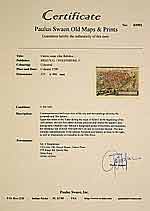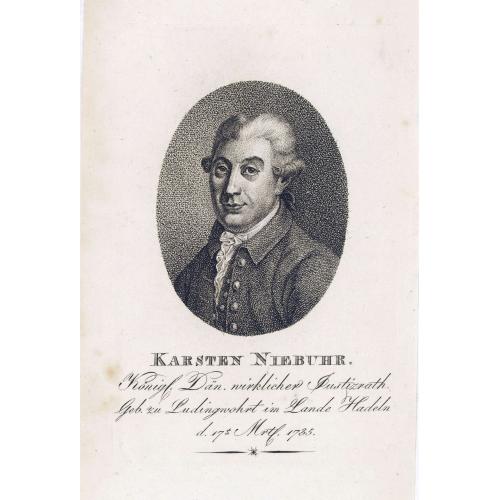Description
Niebuhr was a German mathematician, cartographer, and explorer in the service of Denmark, is renowned for his travels on the Arabian peninsula.
Niebuhr was born the son of a small farmer in Lüdingworth (now a part of Cuxhaven, Lower Saxony) in what was then Bremen-Verden. He had little education, and for several years had to do the work of a peasant. He was interested in mathematics, however, and managed to obtain some training in surveying.
In 1760 one of his instructors suggested that Niebuhr join a scientific expedition being mounted by Frederick V of Denmark to Egypt, Arabia and Syria. Niebuhr studied mathematics for a year and a half before the expedition set out, and also managed to acquire some knowledge of Arabic.
The expedition sailed in January 1761, and, landing at Alexandria, ascended the Nile. Proceeding to Suez, from where Niebuhr made a visit to Mount Sinai, in October 1762 the expedition sailed to Jeddah, and then journeyed overland to Mocha. From Mocha the expedition continued to Bombay, the expedition's artist dying en route and the surgeon soon after landing. Niebuhr was now the only surviving member. He stayed in Bombay for fourteen months and then returned home by way of Muscat, Bushire, Shiraz and Persepolis. His copies of the cuneiform inscriptions at Persepolis proved to be a key turning point in the decipherment of cuneiform, and the birth of Assyriology.
He also visited the ruins of Babylon (making many important sketches), Baghdad, Mosul and Aleppo. He seems also to have visited the Behistun Inscription in around 1764. After a visit to Cyprus he made a tour through Palestine, crossed the Taurus Mountains to Brussa, reached Constantinople in February 1767 and finally arrived in Copenhagen in the following November. In 1776 he was elected a foreign member of the Royal Swedish Academy of Sciences. In 1778 he accepted a position in the civil service of Danish Holstein, and went to reside at Meldorf (Ditmarsh), where he died in 1815.
Works
Niebuhr's first book, Beschreibung von Arabien, was published in Copenhagen in 1772, the Danish government providing subsidies for the engraving and printing of its numerous illustrations.
This was followed in 1774 and 1778 by the two volumes of Niebuhr's "Reisebeschreibung von Arabien und anderen umliegenden Ländern". These works (particularly the one published in 1778), and most specifically the accurate copies of the cuneiform inscriptions found at Persepolis, were to prove to be extremely important to the decipherment of cuneiform writing. Before Niebuhr's publication, cuneiform inscriptions were often thought to be merely decorations and embellishments, and no accurate decipherments or translations had been made up to that point. Niebuhr demonstrated that the three trilingual inscriptions found at Persepolis were in fact three distinct forms of cuneiform writing (which he termed Class I, Class II, and Class III) to be read from left to right.
His accurate copies of the trilingual inscriptions gave Orientalists the key finally crack the cuneiform code, leading to the discovery of Old Persian, Akkadian, and Sumerian.
A fourth volume, also based on materials from the expedition to Arabia, was not published till 1837, long after Niebuhr's death, under the editorship of his daughter. Niebuhr also contributed papers on the interior of Africa, the political and military condition of the Ottoman Empire, and other subjects to a German periodical, the Deutsches Museum. In addition, he edited and published the work of his friend Peter Forsskål, the naturalist on the Arabian expedition, under the titles Descriptiones animalium, Flora Aegyptiaco-Arabica and Icones rerum naturalium (Copenhagen, 1775 and 1776).
French and Dutch translations of Niebuhr's narratives were published during his lifetime, and a condensed English translation of his own three volumes, prepared by Robert Heron, was published in Edinburgh in 1792, under the title "Travels through Arabia". A facsimile edition of this translation, as by "M. Niebuhr", was published in two volumes by the Libraire du Liban, Beirut (undated).
List of Explorers and Mapmakers [+]
FAQ - Guarantee - Shipping
Buying in the BuyNow Gallery
This item is available for immediate purchase when a "Add to Cart" or "Inquire Now" button is shown.
Items are sold in the EU margin scheme
Payments are accepted in Euros or US Dollars.
Authenticity Guarantee
 We provide professional descriptions, condition report (based on 45 years experience in the map business)
We provide professional descriptions, condition report (based on 45 years experience in the map business)
Paulus Swaen warrants the authenticity of our items and a certificate of authenticity is provided for each acquired lot.
Condition and Coloring
We indicate the condition of each item and use our unnique HiBCoR grading system in which four key items determine a map's value: Historical Importance, Beauty, Condition/Coloring and Rarity.
Color Key
We offer many maps in their original black and white condition. We do not systematically color-up maps to make them more sellable to the general public or buyer.
Copper engraved or wood block maps are always hand colored. Maps were initially colored for aesthetic reasons and to improve readability. Nowadays, it is becoming a challenge to find maps in their original colors and are therefor more valuable.
We use the following color keys in our catalog:
Original colors; mean that the colors have been applied around the time the map was issued.
Original o/l colors; means the map has only the borders colored at the time of publication.
Colored; If the colors are applied recently or at the end of the 20th century.
Read more about coloring of maps [+]
Shipping fee
A flat shipping fee of $ 30 is added to each shipment by DHL within Europe and North America. This covers : International Priority shipping, Packing and Insurance (up to the invoice amount).
Shipments to Asia are $ 40 and rest of the world $50
We charge only one shipping fee when you have been successful on multiple items or when you want to combine gallery and auction purchases.
Read more about invoicing and shipping
FAQ
Please have a look for more information about buying in the BuyNow gallery
Many answers are likely to find in the general help section.
Virtual Collection
![]()
With Virtual Collection you can collect all your favorite items in one place. It is free, and anyone can create his or her Virtual map collection.
Unless you are logged in, the item is only saved for this session. You have to be registed and logged-in if you want to save this item permanently to your Virtual Collection.
Read More[+]
Register here, it is free and you do not need a credit card.
Add this item to
Virtual Collection
or click the following link to see my Virtual Collection.
| High-Resolution Digital Image Download | |
|
Paulus Swaen maintains an archive of most of our high-resolution rare maps, prints, posters and medieval manuscript scans. We make them freely available for download and study. Read more about free image download |
In accordance with the EU Consumer Rights Directive and habitually reside in the European Union you have the right to cancel the contract for the purchase of a lot, without giving any reason.
The cancellation period will expire 14 calendar days from the day after the date on which you or a third party (other than the carrier and indicated by you) acquires, physical possession of the lot. To exercise the right to cancel you must inform Paulus Swaen Europe bv, which is offering to sell the lot either as an agent for the seller or as the owner of the lot, of your decision to cancel this contract by a clear statement (e.g. a letter sent by post, or e-mail (amsterdam@swaen.com).
To meet the cancellation deadline, it is sufficient for you to send your communication concerning your exercise of the right to cancel before the cancellation period has expired.
